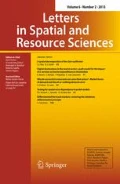Abstract
Takatsuka (Pap Reg Sci 93:595–617, 2014) compares the effects of ad valorem and unit taxes on firm location, within the framework of new trade theory. In the model, the unit tax is imposed at the instant of production, but the ad valorem tax is imposed at the instant of consumption. Since a portion of the good “melts away” during transportation, the actual amount of consumption (tax base) decreases from the point of production. This note presents a consistent application of taxation and clarifies how the timing of taxation characterizes the equilibrium location pattern.
Similar content being viewed by others
Notes
See Keen (1998) for a general review.
The transportation costs in the model correspond partially to packing and transportation/delivery expenses as found in general corporate accounting. However, they are not absolutely identical: the transportation cost in the economic model is broadly interpreted, and includes factors that are associated with non-contiguity, language barriers, exchange rate barriers, insecurity, and other plausible bilateral characteristics. Meanwhile, in corporate accounting, it is defined as the direct expenses a firm incurs when it transfers its inventory or other assets to another location, which is mainly associated with the distance. There have been several attempts to measure the transportation cost, alongside extensive interpretations. See, for instance, Eaton and Kortum (2002) and Anderson and Wincoop (2003, 2004).
Under the assumption of iceberg transportation cost, it appears that the “principle of three” equivalence of gross domestic product (GDP) is not realized, without considering who incurs the transportation costs. However, the mismatch of the “principle of three” equivalence of GDP is dissolved if we implicitly assume there is a competitive transportation sector, in which the iceberg transportation cost meets the disbursements for the services provided by the transportation sector. The treatment of transport sector will be briefly discussed in the final section, referring the works incorporating activities in the transport sector.
References
Anderson, J., van Wincoop, E.: Gravity with gravitas: a solution to the border puzzle. Am. Econ. Rev. 93, 170–192 (2003)
Anderson, J., van Wincoop, E.: Trade costs. J. Econ. Lit. 42, 691–751 (2004)
Behrens, K., Gaigné, C., Thisse, J.-F.: Industry location and welfare when transport costs are endogenous. J. Urban Econ. 65, 195–208 (2009)
Behrens, K., Picard, P.: Transportation, freight rates, and economic geography. J. Int. Econ. 85, 280–291 (2011)
Eaton, J., Kortum, S.: Technology, geography, and trade. Econometrica 70, 1741–1779 (2002)
Keen, M.: The balance between specific and ad valorem taxation. Fisc. Stud. 19, 1–37 (1998)
Takahashi, T.: Economic geography and endogenous determination of transportation technology. J. Urban Econ. 60, 498–518 (2006)
Takatsuka, H.: Tax effects in a two-region model of monopolistic competition. Pap. Reg. Sci. 93, 595–617 (2014)
Acknowledgements
Funding was provided by Japan Society for the Promotion of Science (Grant Nos. 16K12374 and 17H02533).
Author information
Authors and Affiliations
Corresponding author
Rights and permissions
About this article
Cite this article
Ogawa, H., Tsubuku, M. A note on tax analysis in a two-region model of monopolistic competition. Lett Spat Resour Sci 10, 327–335 (2017). https://doi.org/10.1007/s12076-017-0187-9
Received:
Accepted:
Published:
Issue Date:
DOI: https://doi.org/10.1007/s12076-017-0187-9




